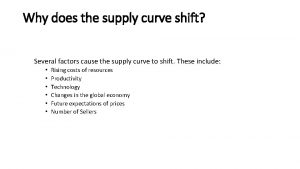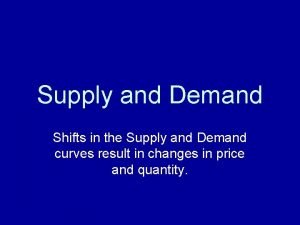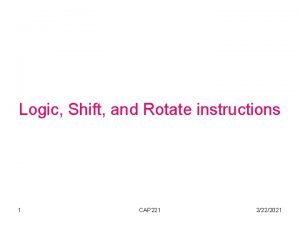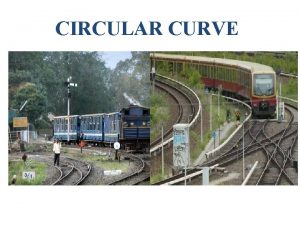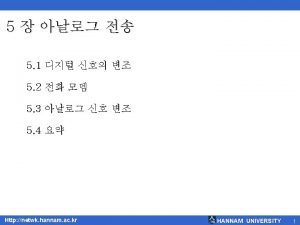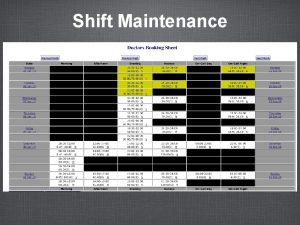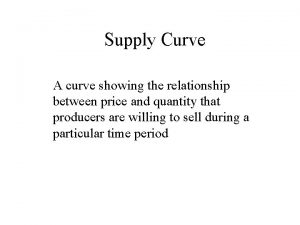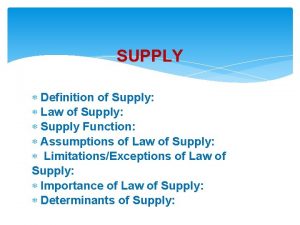Why does the supply curve shift Several factors













- Slides: 13

Why does the supply curve shift? Several factors cause the supply curve to shift. These include: • • • Rising costs of resources Productivity Technology Changes in the global economy Future expectations of prices Number of Sellers

Input Costs • Any changes in the cost of an input used to make a good will affect supply. • A rise in the cost of raw materials, for example, will result in a decrease in supply because the good has become more expensive to produce. The high input costs that dairy farmers pay for feed, labor, and fuel result in higher prices for milk and other dairy products.

Rising Costs and Technology • If costs continue to rise, a firm will have to cut production and lower its marginal cost. • It is possible for input costs to drop. • In many industries, advances in technology can lower production costs. • Examples of technology advances include: • Automation • Computers • E-mail


Cost of Resources • A change in the cost of productive inputs such as land, labor, and capital can cause a change in supply. • Supply might increase because of a lower cost of inputs such as labor or packaging, enabling suppliers to produce more at every price—thereby shifting the supply curve to the right. • An increase in the cost of inputs has the opposite effect. A higher cost of inputs would force producers to offer fewer products for sale at every price—shifting the supply curve to the left.

Government’s Influence • In addition to input costs, the federal government also has the power to affect the supplies of many types of good. • Subsidies • The government often gives subsidies to the producers of a good. • Subsidies generally lower cost, which allows a firm to produce more goods. • Reasons for subsidizing products include: • To provide for people during food shortages • To protect young industries from foreign competition.

Government Influences, cont. • Taxes • Excise taxes increase production costs by adding an extra cost for each unit sold. • They are sometimes used to discourage the sale of a good the government deems harmful, such as cigarettes and alcohol.

Government Influences, cont. • Regulation • Indirectly, government regulation often has the effect of raising costs. • When the government regulated the auto industry to cut down on pollution, these regulations led to an increase in the cost of manufacturing cars.

Non-Price Influences • Changes in the global economy • Since many goods and services are imported, changes in other countries can affect the supply of those goods. • An increase in wages in one country or the increased supply of a good in another will cause the overall supply curve to shift. • Restrictions on imports also affect supply.

Shifts in the Supply Curve • Factors that reduce supply shift the supply curve to the left, while factors that increase supply move the supply curve to the right. • Which graph best represents the effects of higher costs? • Which graph best represents advances in technology?

Future Expectations of Prices • Checkpoint: What happens to supply if the price of a good is expected to rise in the future? • If a seller expects the price of a good to rise in the future, the seller will store the goods now in order to sell more in the future. • If the prices of good is expected to drop in the near future, sellers will earn more by placing goods on the market immediately, before the price falls.

Number of Sellers • If more Sellers enter a market, the market supply will rise and the supply curve will shift to the right. • If Sellers stop producing a good and leave the market, market supply will decline, causing the supply curve to shift to the left.

Where do Firms Produce? • Checkpoint: When is a firm likely to locate close to its consumers? • A key factor in where a firm will locate is transportation. • When inputs such as raw materials are expensive to transport, a firm will locate close to the inputs. • When outputs (the final product) are more costly to transport, firms will locate close to the consumer.
 Supply curve shift to the left
Supply curve shift to the left Supply curve shift right
Supply curve shift right Supply curve shift to the left
Supply curve shift to the left Aggregate of chapter 6
Aggregate of chapter 6 Supply and demand curve shift right
Supply and demand curve shift right Hey bye bye
Hey bye bye Woodward fieser rules for dienes examples
Woodward fieser rules for dienes examples Aniline uv spectrum
Aniline uv spectrum Difference between arithmetic shift and logical shift
Difference between arithmetic shift and logical shift Bathochromic shift and hypsochromic shift
Bathochromic shift and hypsochromic shift Difference between arithmetic shift and logical shift
Difference between arithmetic shift and logical shift Logical shift and arithmetic shift
Logical shift and arithmetic shift Difference between arithmetic shift and logical shift
Difference between arithmetic shift and logical shift Difference between arithmetic shift and logical shift
Difference between arithmetic shift and logical shift
